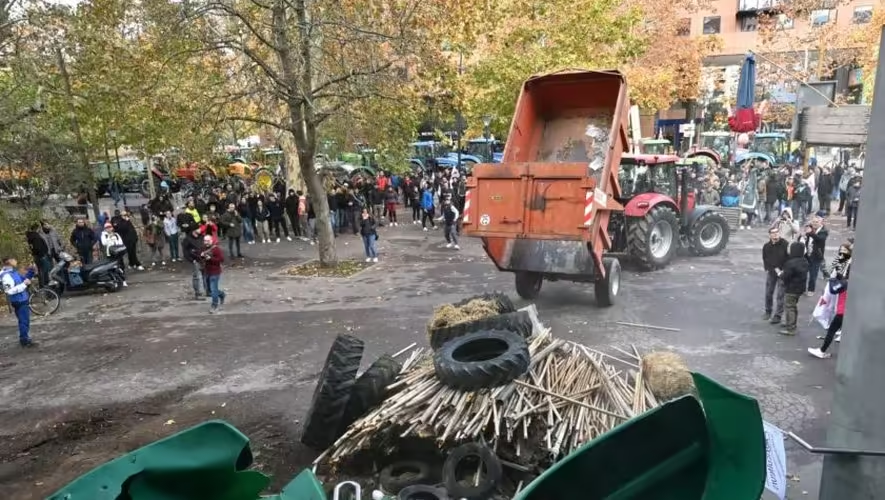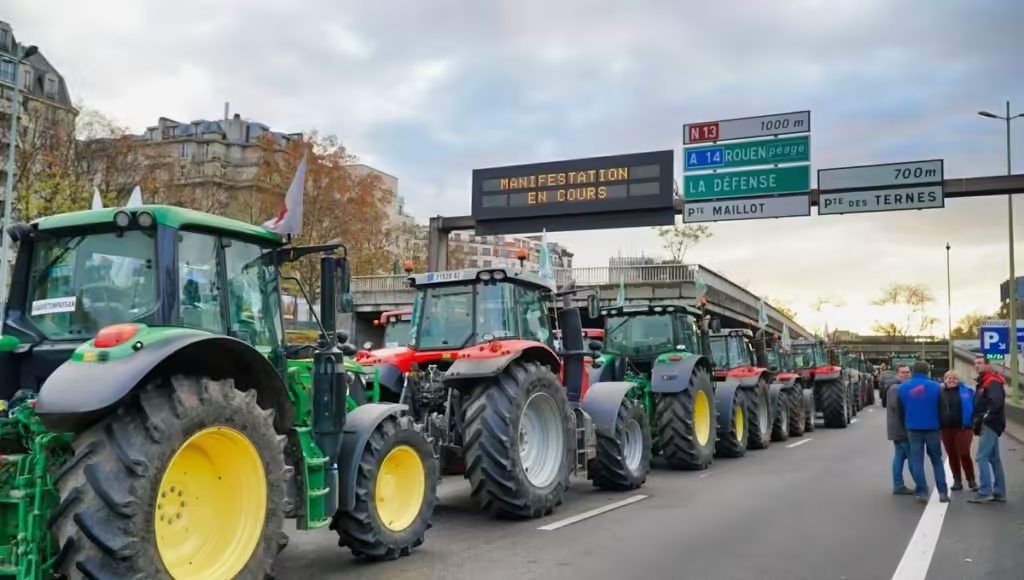Introduction
In recent years, the term “agriculteurs manifestation” has gained significant attention, especially in Europe and other parts of the world where farming communities have risen to express their grievances. These manifestations, or protests, are not just about farmers voicing their concerns but are also deeply intertwined with the socio-economic and political landscapes of their respective countries. This blog will delve into the reasons behind these protests, their historical context, the challenges faced by farmers, the governmental response, and the broader implications for society. By understanding the depth and breadth of these manifestations, we can better appreciate the vital role that agriculture plays in our lives and the challenges that those who work the land must overcome.
1. The Historical Context of Agriculteurs Manifestation
1.1. The Tradition of Agrarian Protest
Agrarian protests are not a new phenomenon. Throughout history, farmers have often found themselves at the mercy of larger socio-economic forces, whether it be feudal landlords, colonial powers, or modern governments. The French Revolution, for instance, was partly fueled by peasant unrest due to high taxes and feudal obligations. Similarly, the early 20th century saw numerous agrarian movements across Europe, Asia, and the Americas as farmers demanded land reforms and fairer treatment.
1.2. Post-World War II Developments
The period following World War II marked significant changes in global agriculture. The Green Revolution brought about increased production through the use of modern techniques, but it also led to a dependency on chemical fertilizers, pesticides, and high-yield crop varieties. While this increased food production, it also created new challenges, such as environmental degradation, loss of biodiversity, and the marginalization of small farmers.
In Europe, the creation of the Common Agricultural Policy (CAP) in the 1960s aimed to support farmers through subsidies and price controls. However, this policy also led to overproduction, market imbalances, and in some cases, the destruction of surplus produce. These factors have contributed to the ongoing discontent among farmers, leading to frequent manifestations.
2. The Key Drivers of Agriculteurs Manifestation

2.1. Economic Pressures
One of the primary reasons behind agriculteurs manifestation is economic pressure. Farmers across the world, particularly in Europe, have been facing declining incomes due to several factors:
- Price Volatility: Agricultural products are subject to price volatility due to factors like weather conditions, global market trends, and changes in demand. This unpredictability can make it difficult for farmers to plan and sustain their livelihoods.
- Rising Costs: The cost of inputs such as seeds, fertilizers, and machinery has been steadily increasing, while the prices farmers receive for their produce have not kept pace. This has led to a squeeze on profit margins.
- Global Competition: Farmers in many regions are facing stiff competition from cheaper imports. Globalization has opened up markets, but it has also exposed local farmers to competition from countries with lower production costs.
2.2. Environmental Challenges
Environmental issues have also been a significant driver of agriculteurs manifestation. Climate change, in particular, has had a profound impact on agriculture:
- Extreme Weather Events: Droughts, floods, and other extreme weather events have become more frequent and severe, disrupting farming activities and reducing crop yields.
- Soil Degradation: Intensive farming practices have led to soil degradation, reducing the fertility of the land and making it harder for farmers to sustain their livelihoods.
- Water Scarcity: In many regions, water scarcity is becoming a critical issue, threatening the viability of agriculture.
2.3. Policy and Regulatory Challenges
Government policies and regulations have also been a significant source of frustration for farmers. While some policies aim to protect the environment or ensure food safety, they can also impose significant burdens on farmers:
- Subsidy Reforms: Changes in agricultural subsidies, particularly in Europe, have often led to protests. Farmers argue that subsidy cuts make it harder for them to compete and maintain their livelihoods.
- Environmental Regulations: While necessary for sustainability, some environmental regulations are seen by farmers as overly restrictive and costly to implement.
- Trade Agreements: International trade agreements can have profound effects on local agriculture. For example, the EU’s trade deals with other countries have sometimes been criticized for favoring imports over local production, leading to protests.
3. Case Studies of Agriculteurs Manifestation
3.1. The French Farmers’ Protests
France has a long history of agriculteurs manifestation, with farmers frequently taking to the streets to express their grievances. The French agricultural sector is one of the largest in Europe, and farmers play a vital role in the country’s economy and cultural identity.
- The 2015 Protests: In 2015, French farmers staged widespread protests against low milk and meat prices, which they argued were unsustainable. The protests included road blockades, dumping manure in public places, and demonstrations at supermarkets. The French government responded with a €600 million aid package, but the underlying issues of price volatility and global competition remained unresolved.
- The 2019 Manure Protest: In 2019, French farmers dumped manure outside government buildings in protest against new agricultural regulations. The protests were sparked by changes to pesticide rules and a perceived lack of support from the government. Farmers argued that the new rules would make it harder for them to compete with foreign producers.
3.2. The Indian Farmers’ Movement
While not in Europe, the Indian farmers’ protests of 2020-2021 are a significant example of agriculteurs manifestation on a massive scale. The protests were sparked by the Indian government’s introduction of three new farm laws, which farmers feared would lead to the deregulation of the agricultural sector and leave them at the mercy of large corporations.
- The Protests: The protests began in Punjab and Haryana, two of India’s most agriculturally productive states, and soon spread to other parts of the country. Tens of thousands of farmers marched to the capital, New Delhi, and set up camps on the outskirts of the city. The protests were marked by mass rallies, hunger strikes, and clashes with the police.
- The Outcome: After a year of sustained protests, the Indian government eventually repealed the farm laws in November 2021. The protests were one of the largest and most sustained agrarian movements in recent history, highlighting the power of collective action.
3.3. The Dutch Farmers’ Protests
The Netherlands, one of the world’s largest agricultural exporters, has also seen significant agriculteurs manifestation in recent years. The Dutch farmers’ protests have been driven by concerns over environmental regulations, particularly those related to nitrogen emissions.
- The 2019-2020 Protests: Dutch farmers staged multiple protests in 2019 and 2020 in response to government plans to reduce nitrogen emissions, which they argued would severely impact their livelihoods. The protests included tractor convoys that blocked highways and disrupted traffic in major cities. Farmers argued that the government’s plans were unfairly targeting agriculture while ignoring other sectors.
- The Government’s Response: The Dutch government responded by promising to review the proposed regulations and engage in dialogue with farmers. However, the protests highlighted the deep divisions between the agricultural sector and environmental policymakers.
4. The Role of Social Media and Technology in Agriculteurs Manifestation

4.1. Mobilization and Organization
Social media has played a crucial role in the organization and mobilization of agriculteurs manifestation. Platforms like Twitter, Facebook, and WhatsApp have allowed farmers to quickly disseminate information, coordinate protests, and build solidarity across regions and even countries.
- Case Study: The Indian Farmers’ Protests: During the Indian farmers’ protests, social media was instrumental in mobilizing support and spreading awareness both within India and internationally. Hashtags like #FarmersProtest trended globally, and the movement garnered support from celebrities and activists worldwide.
- Case Study: The French Farmers’ Protests: In France, social media has also been used to coordinate protests and share real-time updates. Farmers have used platforms like Twitter to share images and videos of their protests, garnering public support and putting pressure on the government.
4.2. Raising Awareness and Shaping Public Opinion
Social media has also been used to raise awareness of the issues faced by farmers and to shape public opinion. By sharing their stories and experiences online, farmers have been able to connect with a broader audience and gain sympathy for their cause.
- Case Study: The Dutch Farmers’ Protests: Dutch farmers used social media to highlight the impact of proposed nitrogen regulations on their livelihoods. They shared videos and images of their farms, as well as testimonials about the challenges they face. This helped to shift public opinion and gain support for their cause.
5. The Government’s Response to Agriculteurs Manifestation
5.1. Dialogue and Negotiation
In many cases, governments have responded to agriculteurs manifestation by engaging in dialogue and negotiation with farmers. This has often involved the formation of committees or working groups to address the issues raised by farmers and to develop solutions.
- Case Study: The French Government’s Response: In response to the 2015 and 2019 protests, the French government engaged in negotiations with farmers’ unions and announced various aid packages and policy changes. However, many farmers felt that these measures were insufficient to address the underlying issues.
- Case Study: The Indian Government’s Response: In India, the government initially resisted the demands of the protesting farmers, but eventually agreed to repeal the farm laws after a year of sustained protests. This was seen as a major victory for the farmers’ movement and a sign of the power of collective action.
5.2. Policy Revisions and Legislative Changes
Governments often respond to agriculteurs manifestations by revisiting and revising agricultural policies and legislation. While such revisions aim to address the immediate concerns of the farmers, they also reflect broader socio-economic priorities.
- Case Study: The Common Agricultural Policy (CAP) Reforms in Europe: The European Union’s CAP has undergone multiple reforms in response to farmer protests. These reforms have aimed to make the policy more sustainable and equitable, balancing the needs of farmers with environmental goals. For example, recent CAP reforms have introduced “green” payments to reward farmers for environmentally friendly practices, although these have been met with mixed reactions from the farming community.
- Case Study: The Repeal of Indian Farm Laws: In response to widespread protests, the Indian government repealed three controversial farm laws in 2021. These laws were initially introduced to liberalize the agricultural sector, but they faced massive resistance from farmers who feared they would be left vulnerable to corporate exploitation. The repeal was a significant political move, showcasing the impact of sustained agrarian pressure on legislative processes.
6. The Socio-Economic Impact of Agriculteurs Manifestation
6.1. Economic Disruptions
Agriculteurs manifestations often lead to significant economic disruptions, both for the agricultural sector and the broader economy.
- Supply Chain Disruptions: Protests can lead to blockades and disruptions in the supply chain, affecting the availability of food products in markets. For instance, during the French farmers’ protests, road blockades and strikes disrupted the supply of milk, meat, and vegetables, leading to shortages and price increases.
- Impact on Agricultural Exports: Countries heavily dependent on agricultural exports may experience economic setbacks due to farmer protests. For example, the Dutch farmers’ protests against nitrogen regulations raised concerns about the potential impact on the country’s agricultural export industry, which is one of the largest in the world.
6.2. Social and Cultural Impact
Agriculteurs manifestations also have profound social and cultural implications. These protests often highlight the deep connection between farmers and their land, as well as the cultural significance of agriculture in many societies.
- Rural Identity and Unity: Farmer protests often serve to strengthen the sense of rural identity and community. The solidarity displayed during these manifestations reinforces the collective identity of farming communities and their shared struggles.
- Public Perception of Agriculture: Protests can also influence public perception of agriculture and the challenges faced by farmers. In many cases, these manifestations have led to increased public support for farmers and greater awareness of the importance of sustainable agriculture.
6.3. Political Consequences
Agriculteurs manifestations can have significant political consequences, influencing government policies and even the outcomes of elections.
- Political Mobilization: Farmer protests often lead to political mobilization, with farming communities becoming more active in advocating for their rights. This can result in the formation of new political movements or increased support for existing ones that champion agricultural issues.
- Electoral Impact: In some cases, agriculteurs manifestations have influenced the outcomes of elections. For example, in India, the farmer protests of 2020-2021 became a major political issue, influencing the results of state elections and putting pressure on the central government to address farmers’ concerns.
7. The Future of Agriculteurs Manifestation
7.1. The Role of Climate Change
As climate change continues to impact global agriculture, it is likely that agriculteurs manifestations will become more frequent and intense. Farmers are on the front lines of climate change, facing challenges such as unpredictable weather patterns, droughts, floods, and soil degradation. These challenges are likely to exacerbate existing economic pressures and lead to more protests.
- Adaptation and Resilience: Future manifestations may focus on demands for greater support for climate adaptation and resilience. Farmers may call for policies that help them transition to more sustainable practices and protect their livelihoods in the face of climate change.
7.2. Technological Advancements
Advances in technology are also likely to shape the future of agriculteurs manifestations. While technology can offer solutions to many of the challenges faced by farmers, it can also introduce new issues, such as the digital divide and concerns over the control of agricultural data.
- Precision Agriculture and Sustainability: Technologies like precision agriculture, which uses data and automation to optimize farming practices, could play a role in addressing some of the concerns raised by farmers. However, access to such technologies may become a point of contention, particularly for small-scale farmers.
- Digital Activism: As digital tools become more widespread, farmers are likely to use them to organize and amplify their protests. Social media and online platforms will continue to play a crucial role in mobilizing support, raising awareness, and putting pressure on governments.
7.3. Global Solidarity and Cross-Border Movements
Agriculteurs manifestations are increasingly transcending national borders, with farmers from different countries expressing solidarity and learning from each other’s struggles.
- Transnational Movements: The global nature of many agricultural challenges, such as climate change, trade policies, and corporate consolidation, is likely to lead to more transnational farmer movements. These movements may advocate for global solutions to issues like fair trade, environmental sustainability, and food sovereignty.
- Shared Strategies and Tactics: Farmers across the world are likely to share strategies and tactics for protest, learning from successful manifestations in other countries. This could lead to the emergence of new forms of collective action and a stronger global voice for farmers.
8. Conclusion
Agriculteurs manifestations are a powerful expression of the challenges and frustrations faced by farmers in today’s world. These protests are not just about specific grievances but are also deeply connected to broader socio-economic, environmental, and political issues. As the world continues to grapple with the effects of climate change, globalization, and technological change, the voices of farmers will remain crucial in shaping the future of agriculture.
Understanding the causes and consequences of agriculteurs manifestations is essential for policymakers, businesses, and the public. By addressing the underlying issues that drive these protests, we can work towards a more sustainable, equitable, and resilient agricultural system that supports farmers and meets the needs of society.
The future of agriculteurs manifestations will likely be shaped by ongoing economic pressures, environmental challenges, and technological advancements. As farmers continue to adapt to these changes, their ability to organize and advocate for their rights will be crucial in ensuring that their voices are heard and their livelihoods are protected.
In the end, the manifestations of farmers are a reminder of the vital role that agriculture plays in our lives and the importance of supporting those who work tirelessly to feed the world. As we look to the future, it is essential that we listen to the concerns of farmers and work together to build a more just and sustainable agricultural system.
References
- (Here, you would typically include references to news articles, academic papers, government reports, and other credible sources that were used to compile the blog.)
Balancing Screen Time and Offline Activities for Optimal Learning










No Comment! Be the first one.